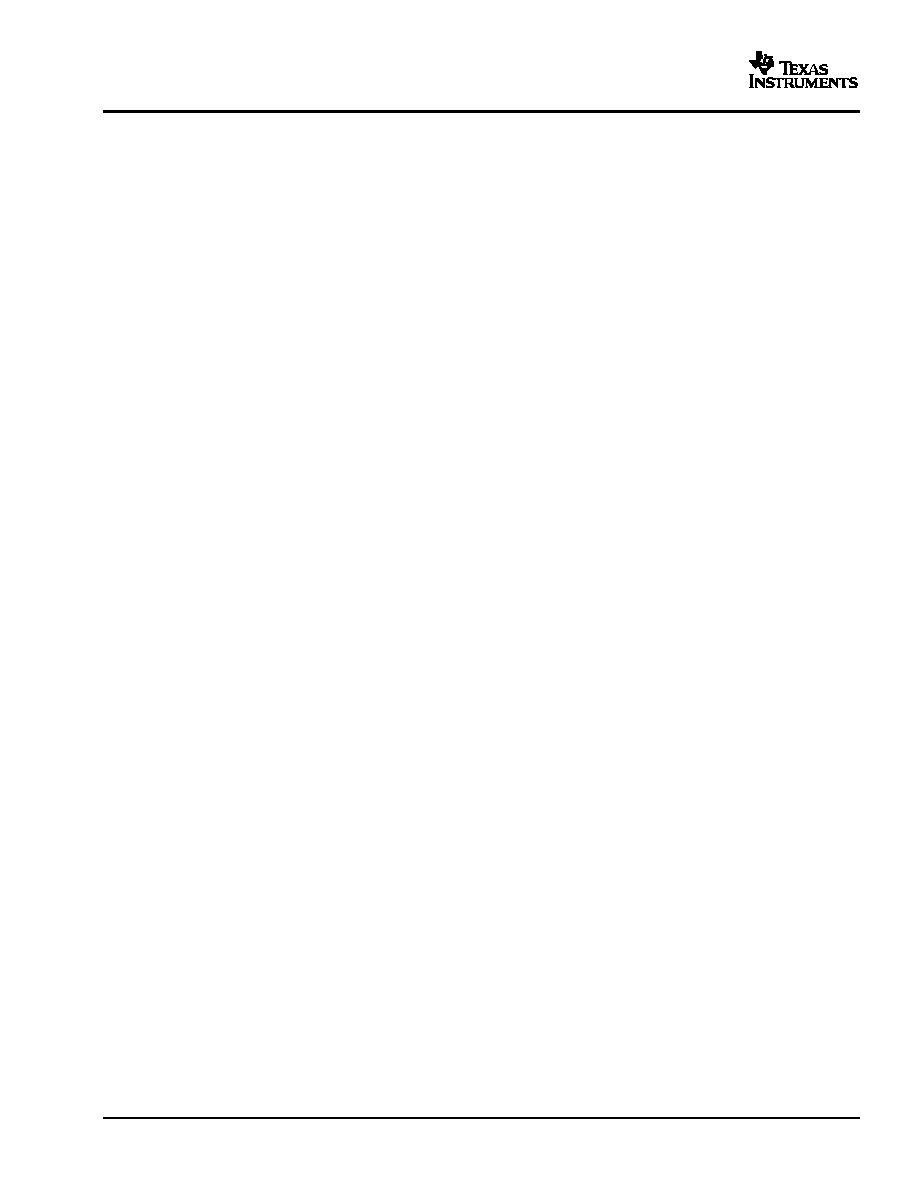- 您現(xiàn)在的位置:買賣IC網(wǎng) > PDF目錄98303 > TSC2302IRGZRG4 (TEXAS INSTRUMENTS INC) SPECIALTY CONSUMER CIRCUIT, PQCC48 PDF資料下載
參數(shù)資料
| 型號: | TSC2302IRGZRG4 |
| 廠商: | TEXAS INSTRUMENTS INC |
| 元件分類: | 消費(fèi)家電 |
| 英文描述: | SPECIALTY CONSUMER CIRCUIT, PQCC48 |
| 封裝: | GREEN, PLASTIC, VQFN-48 |
| 文件頁數(shù): | 61/85頁 |
| 文件大?。?/td> | 1483K |
| 代理商: | TSC2302IRGZRG4 |
第1頁第2頁第3頁第4頁第5頁第6頁第7頁第8頁第9頁第10頁第11頁第12頁第13頁第14頁第15頁第16頁第17頁第18頁第19頁第20頁第21頁第22頁第23頁第24頁第25頁第26頁第27頁第28頁第29頁第30頁第31頁第32頁第33頁第34頁第35頁第36頁第37頁第38頁第39頁第40頁第41頁第42頁第43頁第44頁第45頁第46頁第47頁第48頁第49頁第50頁第51頁第52頁第53頁第54頁第55頁第56頁第57頁第58頁第59頁第60頁當(dāng)前第61頁第62頁第63頁第64頁第65頁第66頁第67頁第68頁第69頁第70頁第71頁第72頁第73頁第74頁第75頁第76頁第77頁第78頁第79頁第80頁第81頁第82頁第83頁第84頁第85頁

www.ti.com
TSC2302
SLAS394 – JULY 2003
The digital decimation filter block includes a high-pass IIR filter for the purpose of removing any dc or
sub-audio-frequency component from the signal. Since such a low frequency filter can have significant settling
time, the filter has an adjustable cutoff frequency, in order to allow the host to set a faster settling time initially,
then later switch it back to a level that does not affect the audio band. The settings for this high-pass filter are:
HPF -3-dB frequency:
0.000019 Fs (0.912 Hz at Fs = 48 kHz)
0.000078 Fs (3.744 Hz at Fs = 48 kHz)
0.1 Fs (4.8 kHz at Fs = 48 kHz)
The filter block provides an audio passband ripple of +/-0.03 dB over a passband from 0 Hz to 0.454 sampling
frequency (Fs), and 70-dB minimum stopband attenuation from 0.548 Fs to 64 Fs.
The ADC modulator and digital filter operate on a clock that changes directly with Fs. This is in contrast to the
DAC, which keeps the modulator running at a high rate of 128 x 44.1 kHz or 128 x 48 kHz even if the incoming
data rate is much lower, such as 8 kHz. Group delay of the ADC path varies with sampling frequency and is
given by 28.7/Fs.
Audio ADC SNR performance is 88-dB-A typical over 20-Hz - 20-kHz bandwidth in 44.1/48-kHz mode with a
3.3-V supply level.
Each audio ADC is preceded by an analog volume control with gain programmable from 20 dB to -40 dB or mute
in 0.5-dB steps using Reg 01h, Pg 2. The input to these volume controls are selected as LLINEIN, RLINEIN,
MICIN, or a mono mix of LLINEIN and RLINEIN through the INML bits (Bits [13:12], Reg 00h, Pg 2). An
additional preamp gain is selectable on the MICIN input as 0 dB, 6 dB, or 12 dB using the MICG bits (Bits [9:8],
Reg 00h, Pg 2).
Audio Bypass Mode
In audio bypass mode, the L/RLINEIN analog inputs can be routed to mix with the DAC output and play to the
headphone outputs (HPL/R) and mono output (MONO). This path has a stereo analog volume control associated
with it, with range settings from 12.0 dB to -35.5 dB in 0.5-dB steps. If the audio ADCs and DACs are not used
while the bypass path is in use, the ADCs and DAC must be powered down to improve noise performance and
reduce power consumption.
This analog volume control has soft-stepping logic associated with it, so that when a volume change is made via
the SPI bus, the logic changes the actual volume incrementally, single-stepping the actual volume up or down
once every 20 sec until it reaches the desired volume level.
This volume control also has similar algorithms as the ADC/DAC volume controls, in that the volume starts at
mute upon power-up, then is slowly single-stepped up to the desired level. At a power-down request, the volume
is slowly single-stepped down to mute before the circuit is actually powered down.
Monophonic Output (MONO)
The mono output of the TSC2302 can be used to drive a power amplifier which drives a low-impedance speaker.
This block can output either a mono mix of the stereo outputs, or the analog input to the left-channel ADC. This
is selected through the MONS bit (Bit 2, Reg 04h, Pg 2). The mono mix of the line outputs is represented by the
equation HPL/2 + HPR/2. Similarly, the mono mix of the analog line inputs is represented by LLINEIN/2 +
RLINEIN/2.
Microphone Bias Voltage (MICBIAS)
The TSC2302 provides an output voltage suitable for biasing an electret microphone capsule. This voltage is
always 1 V below the supply voltage of the part. This output can be disabled through the MIBPD bit (Bit 6, Reg
05h, Pg 2) to reduce power consumption if not used.
64
相關(guān)PDF資料 |
PDF描述 |
|---|---|
| TSDC4872IJT | 1 W, 1 CHANNEL, AUDIO AMPLIFIER, PBGA8 |
| TS4872IJT | 1 W, 1 CHANNEL, AUDIO AMPLIFIER, PBGA8 |
| TSH103ID | 3 CHANNEL, VIDEO AMPLIFIER, PDSO8 |
| TSH103IDT | 3 CHANNEL, VIDEO AMPLIFIER, PDSO8 |
| TSH120ICT | SPECIALTY CONSUMER CIRCUIT, PDSO6 |
相關(guān)代理商/技術(shù)參數(shù) |
參數(shù)描述 |
|---|---|
| TSC2303IZQZ | 制造商:Texas Instruments 功能描述: |
| TSC2303IZQZR | 制造商:Texas Instruments 功能描述: |
| TSC236 | 制造商:TSC 制造商全稱:Taiwan Semiconductor Company, Ltd 功能描述:High Voltage NPN Transistor |
| TSC236CIC0 | 制造商:TSC 制造商全稱:Taiwan Semiconductor Company, Ltd 功能描述:High Voltage NPN Transistor |
| TSC236CZ C0 | 功能描述:兩極晶體管 - BJT High voltage NPN Transistor RoHS:否 制造商:STMicroelectronics 配置: 晶體管極性:PNP 集電極—基極電壓 VCBO: 集電極—發(fā)射極最大電壓 VCEO:- 40 V 發(fā)射極 - 基極電壓 VEBO:- 6 V 集電極—射極飽和電壓: 最大直流電集電極電流: 增益帶寬產(chǎn)品fT: 直流集電極/Base Gain hfe Min:100 A 最大工作溫度: 安裝風(fēng)格:SMD/SMT 封裝 / 箱體:PowerFLAT 2 x 2 |
發(fā)布緊急采購,3分鐘左右您將得到回復(fù)。